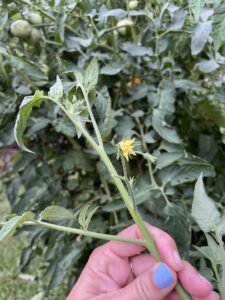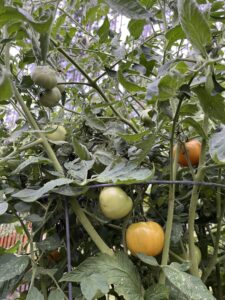Tired Summer Tomatoes
go.ncsu.edu/readext?1082822
en Español / em Português
El inglés es el idioma de control de esta página. En la medida en que haya algún conflicto entre la traducción al inglés y la traducción, el inglés prevalece.
Al hacer clic en el enlace de traducción se activa un servicio de traducción gratuito para convertir la página al español. Al igual que con cualquier traducción por Internet, la conversión no es sensible al contexto y puede que no traduzca el texto en su significado original. NC State Extension no garantiza la exactitud del texto traducido. Por favor, tenga en cuenta que algunas aplicaciones y/o servicios pueden no funcionar como se espera cuando se traducen.
Português
Inglês é o idioma de controle desta página. Na medida que haja algum conflito entre o texto original em Inglês e a tradução, o Inglês prevalece.
Ao clicar no link de tradução, um serviço gratuito de tradução será ativado para converter a página para o Português. Como em qualquer tradução pela internet, a conversão não é sensivel ao contexto e pode não ocorrer a tradução para o significado orginal. O serviço de Extensão da Carolina do Norte (NC State Extension) não garante a exatidão do texto traduzido. Por favor, observe que algumas funções ou serviços podem não funcionar como esperado após a tradução.
English
English is the controlling language of this page. To the extent there is any conflict between the English text and the translation, English controls.
Clicking on the translation link activates a free translation service to convert the page to Spanish. As with any Internet translation, the conversion is not context-sensitive and may not translate the text to its original meaning. NC State Extension does not guarantee the accuracy of the translated text. Please note that some applications and/or services may not function as expected when translated.
Collapse ▲There’s nothing better than homegrown tomatoes picked fresh off the vine, but you may find yourself with plenty of green leaves, tomato flowers, and little to no fruit. What’s going on???
One issue could be that you were a little generous with nitrogen fertilizer early in the season. When I first started gardening I thought the more fertilizer the better, and I dreamed of 2 pound tomatoes on 6 foot plants. More isn’t better though in the case of fertilizer! Excess nitrogen – that would be a high first number in the ratio of 3 numbers on your fertilizer container- encourages leafy growth rather than fruit development, can delay flowering, and reduce the plants’ energy for setting fruit because it’s focusing on making lots of big, beautifully green leaves. Always follow the label recommendations when fertilizing.
Watering and irrigation are as important as proper fertilization too. Tomatoes are sensitive to inconsistent watering. Both overwatering and under-watering can cause flower drop or an imbalance in the ratio of male and female flowers. Fruit formation is reduced when the plant has a low number of female flowers. Plants can also be more prone to blossom end rot and cracking fruit as well.
As North Carolina gardeners know, summers can get hot. High temperatures probably most significantly affect fruit set. Tomatoes experience reduced fruit set when daytime temperatures consistently exceed 90 degrees. Consistent nighttime temperatures above 70 degrees also have an adverse effect on fruit development as well. In addition, pollen can become sterile at higher temperatures, preventing fertilization and tomato formation.
Generally, tomatoes set fruit best when daytime temperatures are between 70-85°F and nighttime temperatures are between 60-70°F. Late April to Mid-June is typically the prime window for strong fruit set. Late June to Early September often brings sustained high temperatures which will likely lead to a significant reduction in fruit set. Gardeners may see a slowdown or even a complete halt in new fruit production during the hottest weeks of summer. Don’t worry! It’s nothing you did wrong. As temperatures cool down again, a second flush of fruit set can occur before the first hard frost as long as your tomato plants are still healthy and relatively pest free.
Overall, to improve tomato production, strive for balanced fertilization, consistent watering, and watch out for hornworms, leaf-footed bugs, and diseases. Also plan to take a little break in harvesting during the hottest part of the North Carolina summer – which isn’t such a bad thing! I’m at the Extension office ready to answer any other questions you may have- come see me anytime to talk tomatoes!





